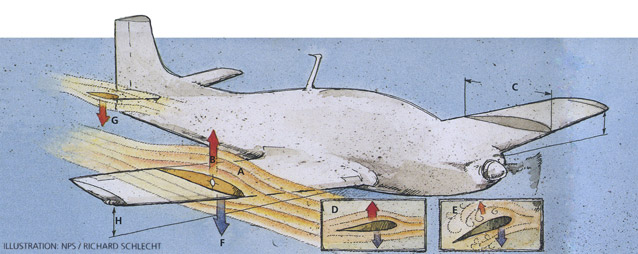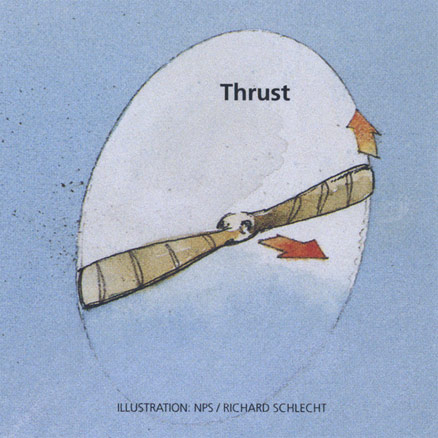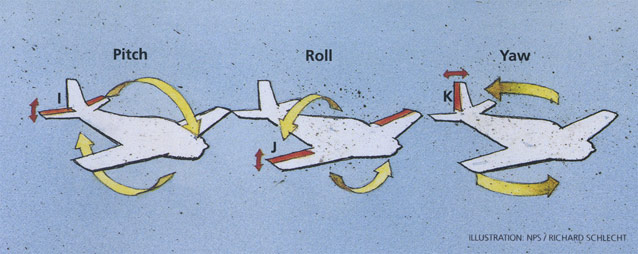Any aircraft design has to solve three critical problems: lift - generating an upward force greater than the weight of the plane; thrust - propelling the plane forward; and control - stabilizing and directing the plane’s flight. Any number of approaches can achieve these results, but natural selection eliminated the early designs that failed to meet the requirements of efficiency, reliability, and durability. The design rapidly evolved into the familiar, basic configuration that virtually all airplanes share.

NPS/Richard Schlecht
Lift
Air passing over the upper surface of a wing (A) has a greater change in velocity (speed and direction), making the air pressure drop relative to the pressure under the wing. Upward lift (B) is created. The degree of curvature of the upper surface and the ratio of the wing span to its cord (distance from the front to the back of the wing) (C) affect lift. The angle of attack - the angle at which the wing meets the air (D) - also affects lift. The greater the angle, the greater the lift - up to a point. Past a certain angle, the smooth flow of the air over the wing suddenly becomes turbulent (E) and "stalling" occurs. That is, lift is lost. At higher speeds, less angle is needed to generate the same amount of lift.

NPS/ Richard Schlecht
Thrust
Just as air flow over the wings generates lift, air flow over the rapidly turning blades of a propeller-driven plane produces thrust, or forward motion. Each blade of the propeller acts as a small airfoil, or wing. As the blade rotates, air flows over its curved surface. The resulting horizontal "lift" propels the aircraft forward. Because the velocity of the blade increases from hub to tip, the blade is twisted, providing the most efficient angle of attack at each point along its length.

NPS/Richard Schlecht
Control
A wing is inherently unstable fore-and-aft. This is because lift (B) is greatest behind the center of gravity (F) making the wing rotate around that point. The nose pitches down, the tail comes up. To counteract this, the horizontal stabilizer (G) acts as an inverted wing, creating negative lift to hold the tail down. Lateral stability of the plane is affected by the amount of dihedral (H); the deflection from horizontal built into the wings. Movable control surfaces produce the three movements needed for maintaining control of the aircraft and changing direction. The elevator (I) produces pitch (up-down movement of the nose), for longitudinal control. Ailerons (J) produce roll (rotation of the wings), for lateral control.The rudder (K) produces yaw (right and left movement), for directional control. These movements in combination turn the aircraft.
Last updated: September 14, 2017
